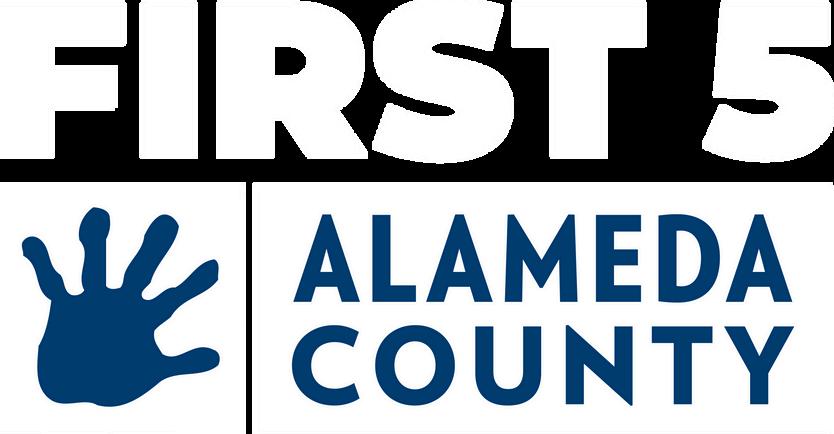

DATA FOR ACTION 2025
Building coordinated systems that center the whole community, whole family, and whole child requires teamwork, collaboration, and data-informed collective action from partner agencies, community-based organizations, advocates, and decision-makers to promote equitable policies and inform systemic solutions across local, state, and federal levels.
ALAMEDA COUNTY IS A POPULOUS COUNTY


COUNTY IS A HIGH COST OF LIVING COUNTY
1,663,823 babies born in 2021 16,900
total population in 2022
109,579
children under age 6, 6.4% of the total population (2022) households with children under age 6 ~71,000
ALAMEDA COUNTY IS A DIVERSE COUNTY
7th 46%
most diverse county in the US (2020) of Alameda County residents over 5 live in households where a language other than English is spoken at home (2022) of children under 6 estimated to live in families with at least one foreign-born parent (2022) 53%
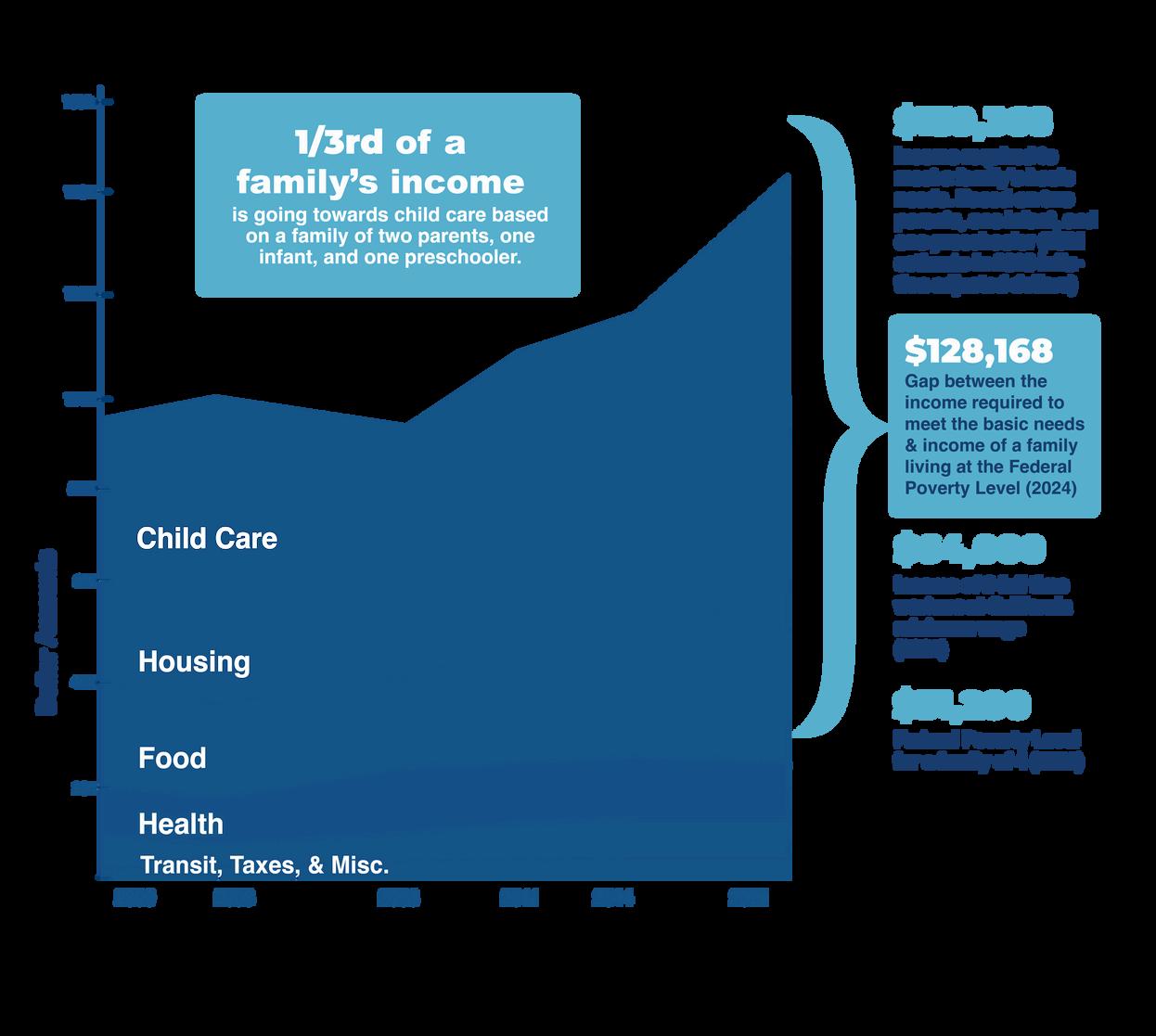
ALAMEDA
FINANCIAL REALITIES FOR FAMILIES IN ALAMEDA COUNTY
COST OF LIVING CONTINUES TO RISE AT AN UNSUSTAINABLE RATE
FAMILIES WITH CHILDREN ACCESSING SOCIAL SAFETY NET SUPPORTS
increase in cost of child care (2014-2021) 68%
cumulative inflation rate over the past four years 22%
renters pay more than 1/3 income for rent 50%
First 5 advocates for policies that advance economic justice and support strategies that guarantee families have sufficient income to meet basic needs and create enriching home environments Accessing safety net services such as Medi-Cal, CalFresh and early care and education subsidies and supports is a key strategy to address the financial strain families face
46,269
of households where all parents are in the labor force 69%
of households in Alameda County struggle to meet their basic needs 29%
24,152
children under 6 are enrolled in Medi-Cal (~4 out of 10 children under 6)
families utilizing WIC benefits in 2021 (~1 out of 3 families with children under 6)
families unable to afford diapers 1 in 3
children in Alameda County experienced food insecurity 1 in 10 people in families were estimated to be homeless in 2024 count 699
THE COST OF LIVING DISPROPORTIONATELY AFFECTS WOMEN & PEOPLE OF COLOR
women face economic insecurity 1 in 3 WHAT DOES THE HIGH COST OF LIVING MEAN?
of households that struggle to meet their basic needs are headed by a person of color
22,649
children under 6 are enrolled in CalFresh (~2 out of 10 children under 6)
1 in 4
families use Medi-Cal to pay for the birth of their children
of people in families experiencing homelessness were in sheltered care - a 24% increase from 2022 85%
11,722
children under 6 accessed a subsidy for children (~1 out of 10 children under 6)
SPOTLIGHT ON GUARANTEED INCOME PILOT
100% families in the 2021-22 Kindergarten Readiness Assessment who participated in the Oakland Resilient Families Guaranteed Income pilot reported significantly higher kindergarten readiness than other similar families. The pilot, which ran from 2021-2023 provided $500 monthly
ADDRESSING RACIAL DISPARITIES IN
FAMILY HEALTH & WELL-BEING
We center equity in our research, advocacy, and policy to create conditions and systems where children can reach their full potential. Infants, children and women, especially those who identify as people of color, bear the brunt of structural inequities These disparities most impact Black, Asian Pacific Islander and Native American communities.
STRUCTURAL INEQUITIES LEAD TO RACIAL DISPARITIES
Black women and birthing people are 3x more likely to die during pregnancy or childbirth and to experience more maternal health complications.
Black babies are 34x more likely to be born too early, too small, or to die before their first birthday
SUPPORTING THE HEALTH & WELL-BEING OF FAMILIES
Family health and well-being is supported by connection to community-based resources through family navigations and access to health and mental health services that are culturally inclusive and include vision, dental, screenings, and preventive care of parents/caregivers expressed concern about their child’s health and well-being
65%
67% of families indicated that help connecting to resources was important to them; only 12% of all families had received this assistance
Pacific Islander babies are 1.7x more likely than White babies to be born premature. of children who regularly attended well-child visits missed these visits over the past three years 40%
STRUCTURAL RACISM IMPACTS BLACK MATERNAL HEALTH
In Alameda County, Black women and families are 2x more likely to live in poverty or experience hardships during pregnancy
2 out of 3
Parents of children ages 3-6 reported that their children had not received a developmental screening and only 6% of parents reported their children having an Adverse Childhood Experience (ACEs) screening.
of 58 counties for adequacy of prenatal care. 6 in 10 women receive adequate prenatal care. Less than half of mothers who identify as Pacific Islander received adequate prenatal care the lowest of any race group.
1,400
In Alameda County, Black mothers have the highest gestational hypertension rates
— 2 5x > than Asian mothers
LACK OF ACCESS TO HIGH QUALITY, RESPECTFUL CARE
A recent national survey of Black women who used health care in the past three years found that 34% report at least one of three consequences because of a negative experience with a health care provider for any reason: worse health (13%), being less likely to seek care (19%), or switching providers (27%) NEIGHBORHOOD CONDITIONS
SPOTLIGHT ON PEDIATRIC CARE COORDINATION
First 5 Alameda County Pediatric Care Coordination services connect children to preventive care, early intervention and community supports for optimal growth and development. First 5's care coordinators provide families with culturally tailored navigation assistance to resources such as mental health, dental care, regional center programming, food access, housing, child care, healthcare and other basic needs In a recent survey of Alameda County parents, children who regularly attended well-child visits had a higher level of kindergarten readiness.
ACCESS TO CHILD CARE
Scarcity of public resources limits the existence of, and access to, quality child care and quality communitybased programming Even prior to the COVID-19 pandemic, the ECE system suffered from low supply and high cost. The shortage of licensed child care is particularly acute in infant and toddler settings.
A STABLE & SUPPORTED WORKFORCE IS CRITICAL FOR ENSURING ACCESS TO EARLY CARE & EDUCATION
75% of early childhood educators in the county worry about paying monthly bills and over 50% worry about food security.
The earnings range from a mean of $55K for preschool teachers to $46K for ECE workers in our region, leaving many educators to worry about meeting their own basic needs.
The adverse effects of low compensation disproportionately impact women, and in particular, women of color, with 96% of our ECE workforce identifying as women and nearly 80% as women of color.
On average, ECE educators earn half of elementary school teachers
CHILD DESERVES ACCESS TO SAFE SPACES
From 2019 to 2021, there were 21 fewer licensed centers and 270 fewer family child care (FCC) sites in Alameda County.
There is a significant need for investment and expansion in ECE licensed facilities. We estimate that the facilities cost to meet demand for licensed ECE child care in Alameda is likely in the range of $2 billion to $4 billion
65% of child care sites reported at least one of their property components is inadequate, substandard, or worse, while 29% of sites reported that six or more of their property components are inadequate, substandard, or worse.
Infant/Toddler Unmet Need for Subsidized Care (2021)
Preschool Unmet Need for Subsidized Care (2021)
SPOTLIGHT ON MEASURE C
Measure C, the Children's Health and Child Care Initiative, is a 0.5% sales tax that was approved by voters in March 2020 to generate approximately $150 million annually for expanding access to early childhood education and health care in Alameda County. Measure C funding will help enhance the quality of early care and education (ECE) programs and increase access to high-quality early learning programs for low- and middle-income families in Alameda County. It will also improve compensation for participating ECE providers and enhance professional development programs and the eligibility and enrollment system for providers, as well as fund facilities improvements to ECE sites and other early childhood spaces.
CHILDREN UNDER THE AGE OF SIX WHO

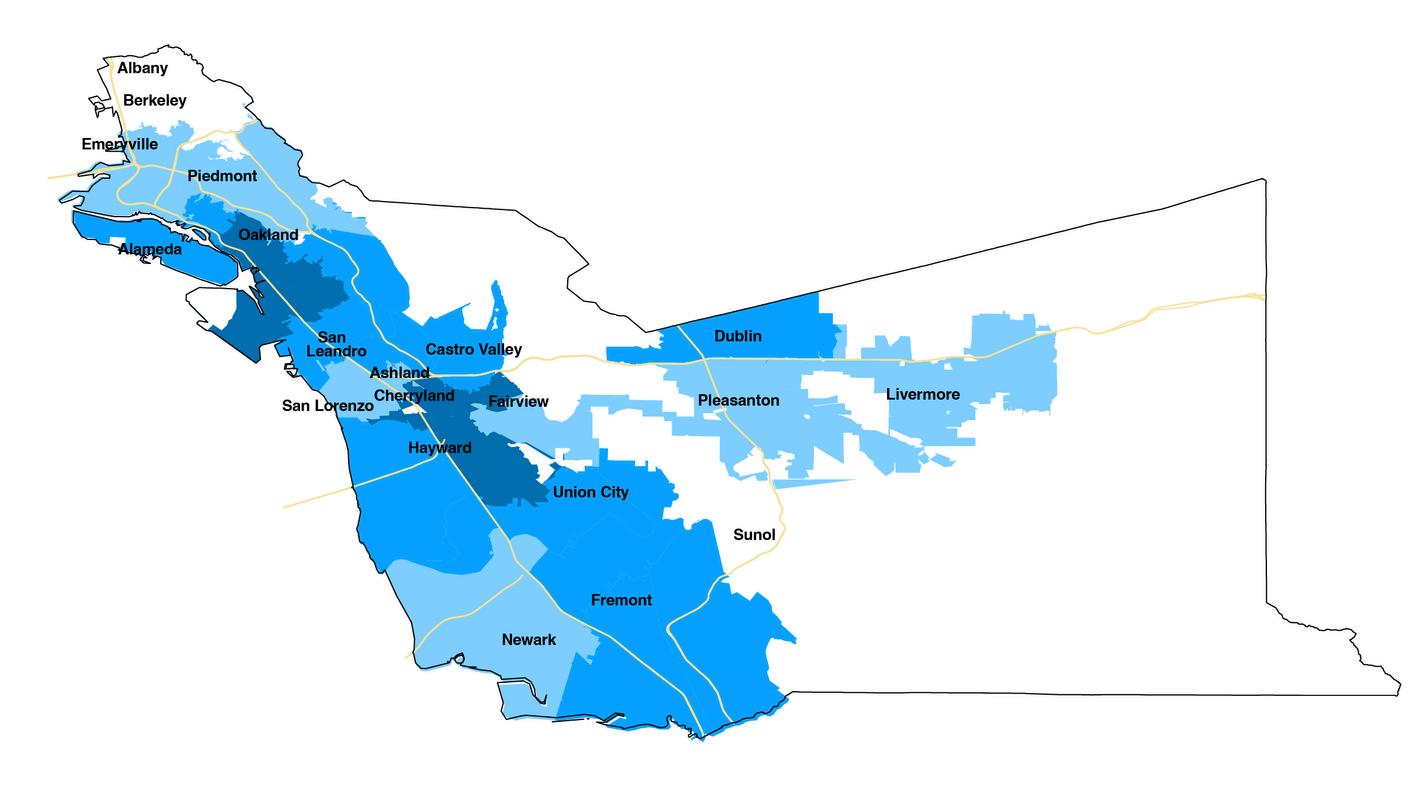
KINDERGARTEN READINESS
At First 5 Alameda County our “North Star,” the population result that guides our work, is that all children are ready for kindergarten. Our work is to ensure that policies, systems, communities, and schools support families and children by creating the conditions that position all for success We find that differences in kindergarten readiness are closely associated with socioeconomic conditions rooted in structural racism and classism and disinvestment in neighborhoods.
KINDERGARTEN READINESS IN 2021-2022
According to parents/caregivers, 33% of children were fully ready for kindergarten compared to 44% in 2019 Structural inequities compounded by the COVID-19 pandemic have impacted children, families, and communities.
Achievement gaps persist for children who are not ready for kindergarten.
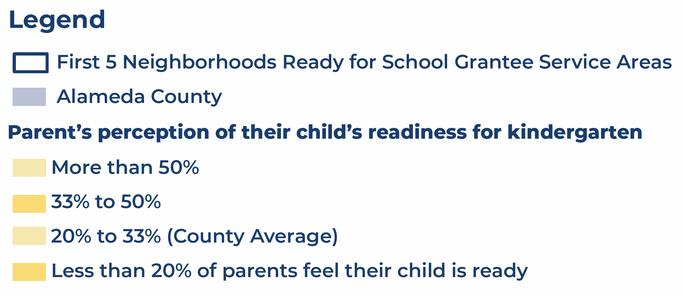
children who are not ready for kindergarten continue to struggle academically in third grade (2018).
Our 2021-22 Kindergarten Readiness Assessment found that receiving support from the place-based Neighborhoods Ready for School initiative was associated with higher readiness overall
First 5 Alameda County is proud to share that the Early Development Instrument (EDI) has been formally adopted countywide to comprehensively measure the various factors that impact kindergarten readiness First 5 engaged in a participatory process, in partnership with the Alameda County Office of Education, to select a tool that will help us better understand kindergarten readiness among the County’s youngest learners. The goal is to administer the EDI to every kindergarten-age public school student in the county beginning in academic year 2025-26. The data we collect will paint a detailed picture of what our communities’ young children are experiencing, and where we can invest to help them and their families thrive. This new assessment tool is an important step towards a future where every child in Alameda County starts kindergarten ready to succeed.
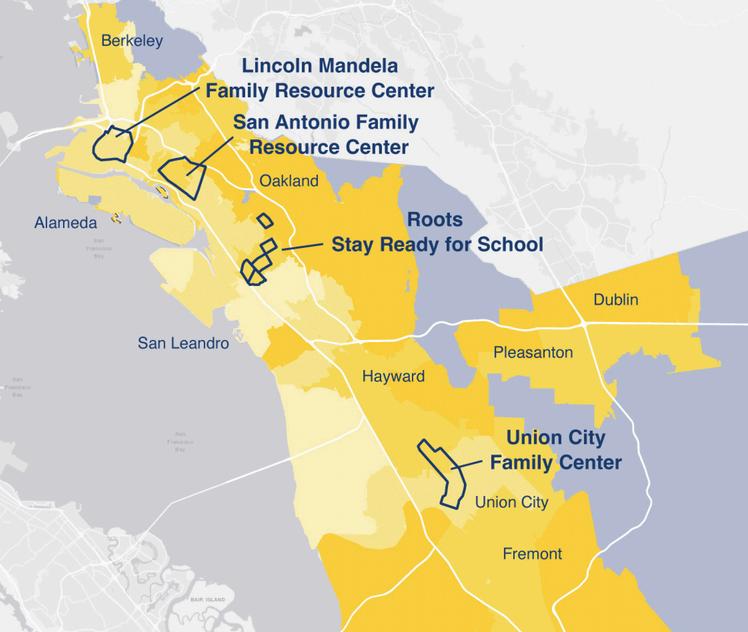
CITATIONS
2.
1 California Department of Public Health (2021). "Cal-Vida Birth Data." California Department of Public Health, https://cal-vida cdph ca gov/ Accessed 8/23/2024.
3
U S Census Bureau (2022) Table B01003: Total Population American Community Survey 5-Year Estimates. Retrieved from https://data.census.gov/.
U S Census Bureau "Gross Rent as a Percentage of Household Income in the Past 12 Months: 2022." American Community Survey 5-Year Estimates, Table B25070, https://data.census.gov.
U S Census Bureau (2022) Table B27001: Health Insurance Coverage Status by Sex by Age. 2022 American Community Survey 5-Year Estimates. Retrieved from https://data.census.gov/.
4 U.S. News & World Report. "The 15 Most Diverse Counties in the U.S." U.S. News & World Report, 2021, https://www.usnews.com/news/healthnews/slideshows/the-15-most-diverse-counties-in-the-us Accessed 11 Dec 2024.
U S Census Bureau (2022) Family Type by Presence and Age of Own Children Under 18. American Community Survey 5-year estimates (B11003). Retrieved from https://data census gov/
5. U S Census Bureau "Age and Nativity of Own Children Under 18 Years in Families and Subfamilies by Nativity of Parents: 2022 " American Community Survey 5-Year Estimates, Table B05009, https://data.census.gov.
6 U S Census Bureau "Household Language by Household Limited English Speaking Status: 2023." American Community Survey 5-Year Estimates, Table B16002, https://data.census.gov.
7 Insight Center (2021) California Family Needs Calculator (formerly the California Family Economic Self-Sufficiency Standard or Self-Sufficiency Standard), Alameda County Retrieved from https://insightcced org/familyneeds-calculator/
9.
8 California Department of Developmental Services. (2024). Minimum Wage –2024 Based on two workers working 40 hours per week, 50 weeks per year Retrieved from https://www.dds.ca.gov/rc/vendor-provider/minimum-wage/
10
U S Department of Health and Human Services "Poverty Guidelines " Office of the Assistant Secretary for Planning and Evaluation, 2023, https://aspe.hhs.gov/topics/poverty-economic-mobility/poverty-guidelines. Accessed 8/23/2024
Insight Center (2021). Family Needs Indicator - Alameda County Fact Sheet. Retrieved from: https://insightcced org/the-cost-of-being-californian-alamedacounty-fact-sheet/ 11.
12.
U.S. Bureau of Labor Statistics. "Consumer Price Index." U.S. Bureau of Labor Statistics, https://www bls gov/cpi/ Calculated using December CPI change from 2020-2023.
U S Census Bureau "Age of Own Children Under 18 Years in Families and Subfamilies by Living Arrangements by Employment Status of Parents: 2022." American Community Survey 5-Year Estimates, Table B23008, https://data census gov National Diaper Bank Network. (2021) Diaper Need and Its Impact On U.S. Families. Retrieved from https://nationaldiaperbanknetwork.org/wpcontent/uploads/2019/02/Diaper-Need-and-Its-Impact-on-US-Families pdf ACPHD. Healthy Alameda County website. Child Food Insecurity Rate. (2018). Retrieved from http://www healthyalamedacounty org/indicators/index/view? indicatorId=2108&localeId=23
U.S. Department of Housing and Urban Development. "Alameda County EveryOne Counts! 2022 Homeless Point-in-Time Count and Survey Report " EveryOne Home, September 2022, https://everyonehome.org/wp-content/uploads/2022/12/2022Alameda-County-PIT-Report 9 22 22-FINAL-3 pdf Accessed 11 Dec 2024
Alameda County Social Services Agency (2021) Medi-Cal enrollment numbers represent a cumulative count for 2023.
Data Analysis, Research and Evaluation Section Women, Infants and Children (WIC) Division, California Department of Public Health. 2023. WIC-Redemption-by-County-byParticipant-Category-Data.csv.
Alameda County Social Services Agency (2021) CalFresh enrollment numbers represent a cumulative count for 2023.
California Department of Public Health (2021) "Cal-Vida Birth Data " California Department of Public Health, https://cal-vida.cdph.ca.gov/. Accessed 8/23/2024.
Subsidy utilization is a combination of contractor reporting to Quality Counts (22- 23), Alternative Payment Voucher claims (22-23) and California Department of Education TK enrollment (SED students only)
Applied Survey Research (2021) 2021-2022 Kindergarten Readiness in Alameda County. Retrieved from http://www.first5alameda.org/kindergarten-readinessassessment
Alameda Public Health Department (n d), Perinatal Equity Initiative webpage Retrieved from https://acphd.org/programs-and-services/perinatal-equity-initiative/ Alameda County Public Health Department "Alameda County Maternal, Infant, and Young Child Health Indicators Table." Alameda County Public Health Department, February 2023, https://acphd-web-media.s3-us-west-2.amazonaws.com/media/datareports/mpca/docs/acphd-mpcah-indicators-table-feb-2023 pdf Accessed 11 Dec 2024.
Alameda County Public Health Department "Alameda County Maternal, Infant, and Young Child Health Indicators Table." Alameda County Public Health Department, February 2023, https://acphd-web-media.s3-us-west-2.amazonaws.com/media/datareports/mpca/docs/acphd-mpcah-indicators-table-feb-2023 pdf Accessed 11 Dec 2024.
CITATIONS
California Department of Public Health "Centering Black Mothers: Maternal and Infant Health in California." Maternal, Child and Adolescent Health, April 2023, https://go cdph ca gov/centering-black-mothers Accessed 11 Dec 2024
California Budget & Policy Center. "Women's Well-Being Index." California Budget & Policy Center, https://calbudgetcenter.org/resources/womens-well-being-index/. Accessed 11 Dec 2024
Webster, D., et al. California Child Welfare Indicators Project Reports. UC Berkeley Center for Social Services Research (Jul 2019)
Center for the Study of Child Care Employment. Alameda County SEQUAL Report. University of California, Berkeley, 2016.
U S Bureau of Labor Statistics "Wages by Area and Occupation " U S Bureau of Labor Statistics, https://www.bls.gov/bls/blswage.htm. Accessed 11 Dec. 2024.
California Early Care and Education (ECE) Workforce Registry (October 2023)
Note: Self-reported data for 5,637 people registered in the Alameda County Workforce Registry as of October 2023. The Workforce Registry only represents a subset of the ECE workforce as it is a voluntary database The registry includes an overrepresentation of those working at child care centers and Title 5 programs compared to other child care program types Registry participants report wages as an hourly gross rate or annual, monthly, or weekly gross salary Annual wage was calculated by multiplying their self-reported wage and their self-reported number of hours worked by 50 weeks
Data provided by the California Resource and Referral Network (2021
First 5 Alameda County analysis conducted in October 2021 Estimates suggest that, based on population, Alameda County could see nearly 4,000 more subsidized slots based on the 2021-22 adopted budget Meanwhile, estimates suggest that the new reimbursement rates could bring an increase of over $20 million countywide to subsidized child care providers just for the slots for children age 0-5 currently in the system (estimates based on assumption of full day care rates). The Center for American Progress provides estimates of the true costs of care for child care programs in California
First 5 Alameda County. "Facilities Needs Assessment 2022." First 5 Alameda County, 2022, https://www first5alameda org/files/Facilities%20Needs%20Assessment%202022 %20V2.pdf. Accessed 11 Dec. 2024.
Alameda County Early Care and Education Planning Council (2021) Alameda County Early Care and Education Needs Assessment. Retrieved from: http://www.first5alameda.org/ files/2021%20Alameda%20County%20ECE%20Needs%20 Assessment%20FINAL.pdf
U S Census Bureau "2022 American Community Survey 5-Year Public Use Microdata Sample (PUMS) " U S Census Bureau, https://data census gov Accessed 11 Dec. 2024.
Applied Survey Research (2018) Kindergarten Readiness and Later Achievement, A Longitudinal Study in Alameda County. Retrieved from http://www.first5alameda.org/files/Alameda%20 Longitudinal%20KRA%20Study%20Final pdf
